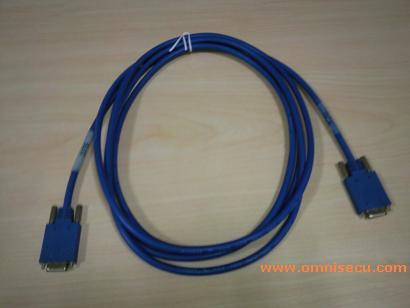How to configure Router Serial Interfaces, DTE (Data Terminal Equipment) and DCE (Data Communications Equipment)
When connecting a serial cable to the serial interface of the router, clocking is provided by an external device, such as a CSU/DSU device. A CSU/DSU (Channel Service Unit/Data Service Unit) is a digital-interface device used to connect a router to a digital circuit. The router is the DTE (Data Terminal Equipment) and the external device is the DCE (Data Communications Equipment), where the DCE provides the clocking. However, in some cases we might connect two routers back-to-back using the routers’ serial interfaces (Example: Inside the router labs). Each router is a DTE by default. The cable decides which end to be DCE or DTE and it is usually marked on the cable. The picture below shows back to back cable.

If is not marked, we can use the Cisco IOS show command "show controller" command to determine the interface is DTE or DCE. Since clocking is required to enable the interface, one of the two routers should function as DCE and should provide clocking. This can be done by using the "clock rate" command, from the interface configuration mode.
To find the possible clock rate values, get the command help by using a question mark after the "clock rate" from the serial interface configuration mode, as shown below.
Router(config-if)# clock rate ?The output for above command is shown below.
R1>
R1>enable
R1#configure terminal
Enter configuration commands, one per line. End with CNTL/Z.
R1(config)#interface serial 1/0
R1(config-if)#clock rate ?
With the exception of the following standard values not subject to rounding,
1200 2400 4800 9600 14400 19200 28800 38400
56000 64000 128000 2015232
accepted clockrates will be bestfitted (rounded) to the nearest value
supportable by the hardware.
246-8064000 DCE clock rate (bits per second)
These values are in bites per second. You can find the possible values by using help.
Router(config)# interface s0/1
Router(config-if)# clock rate 64000
All interfaces have a bandwidth value assigned to them. This is used by certain routing protocols, such as IGRP, OSPF, and EIGRP, when making routing decisions.
For LAN-based interfaces, the speed of the interface becomes the bandwidth value (In kilobits per second (Kbps)). However, on synchronous serial interfaces, the bandwidth defaults to 1,554Kbps and this is not related with the clock rate set. To change the bandwidth value for an interface, use the bandwidth Interface Subconfiguration mode command:
Router(config)# interface s0 Router(config-if)#bandwidth 64